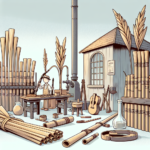The Fascinating Journey of Clarinet Reed Evolution
The clarinet reed has undergone significant changes over the centuries, reshaping how musicians interact with and experience the clarinet. Whether you're an experienced player or a curious beginner, understanding the history and innovations of clarinet reeds can greatly improve your playing experience. Join us as we explore this captivating journey!
In the early days, clarinet reeds were crafted from cane, sourced from regions abundant in this sturdy grass. Cane has been the go-to choice since the early days of woodwind instruments. Musicians favored this material for its natural springiness and ability to create a warm, rich tone. While early clarinetists knew their reeds influenced the sound, the finer points of reed usage remained somewhat mysterious.
Reed Evolution Timeline
| Era | Development |
|---|---|
| Early Days | Cane reeds, basic understanding of sound production |
| Late 19th Century | Experimentation with cuts and shapes, introduction of Boehm system |
| 20th Century | Introduction of synthetic reeds, advancements in technology and materials science |
| Present Day | Variety of materials and crafting techniques, personalized reed options |
19th Century Advancements
A century or two later, we see a big jump in understanding how reeds affect playability. In the late 1800s, musicians started trying out different cuts and shapes. The Boehm system brought a more uniform approach to making reeds. Imagine how excited clarinetists must have been as they tested various thicknesses and profiles, all in pursuit of the perfect sound!
20th Century Innovations
The evolution didn't stop at cane. The 1900s brought synthetic reeds into the picture. Although initially viewed with doubt, synthetic reeds have gained popularity among many players. They offer consistent performance and aren't affected by many environmental factors that can ruin a cane reed's sound.
Modern Reed Crafting
It's amazing how technology has influenced these innovations. Today's clarinetists benefit from exact cutting methods and advanced materials. You can find reeds made from various materials, including plastics, that offer both durability and excellent sound. Current crafting methods ensure players can find reeds that match their style, whether they want a bright, clear tone or a warm, soft sound.
Choosing the Right Reed
When selecting a reed, think about your playing style. Your reed choice is important whether you play jazz, classical, or modern genres. Many musicians are amazed at how much the reed affects overall playability. The reed's strength, shape, and material all influence how your instrument responds and the type of tone you produce.
Reed Strength for Beginners
For newcomers, picking the right reed strength can be tricky! Clarinet reeds come in various strengths, typically from 1 to 5. Understanding how reed strength affects sound production can make a big difference in your experience. As a rule of thumb, beginners should start with a softer reed, which is easier to blow and puts less strain on the mouth muscles.
Experimenting with Reeds
As you improve, you might find that trying different Martin Freres reeds helps you grow as a clarinetist. These reeds are carefully made, considering input from musicians worldwide. Martin Freres has become a name associated with quality in the clarinet world due to their dedication to excellence.
Reed Crafting Artistry
We shouldn't forget the skill involved in making these reeds. Some players even try making their own, carefully shaping and sanding until they find the perfect sound for their style. It's a fascinating aspect of musicianship. Making your own reeds can help you feel more connected to your clarinet.
Conclusion
The story of clarinet reed development is closely tied to the broader history of music. As musicians keep pushing boundaries and coming up with new ideas, reed-making techniques will surely continue to advance. So, fellow clarinetists, whether you prefer synthetic options or traditional cane, remember that your reed is an extension of yourself. The sound you create starts with that small piece of carefully crafted material. Enjoy the journey, and may your playing always be lively and full of personality!







